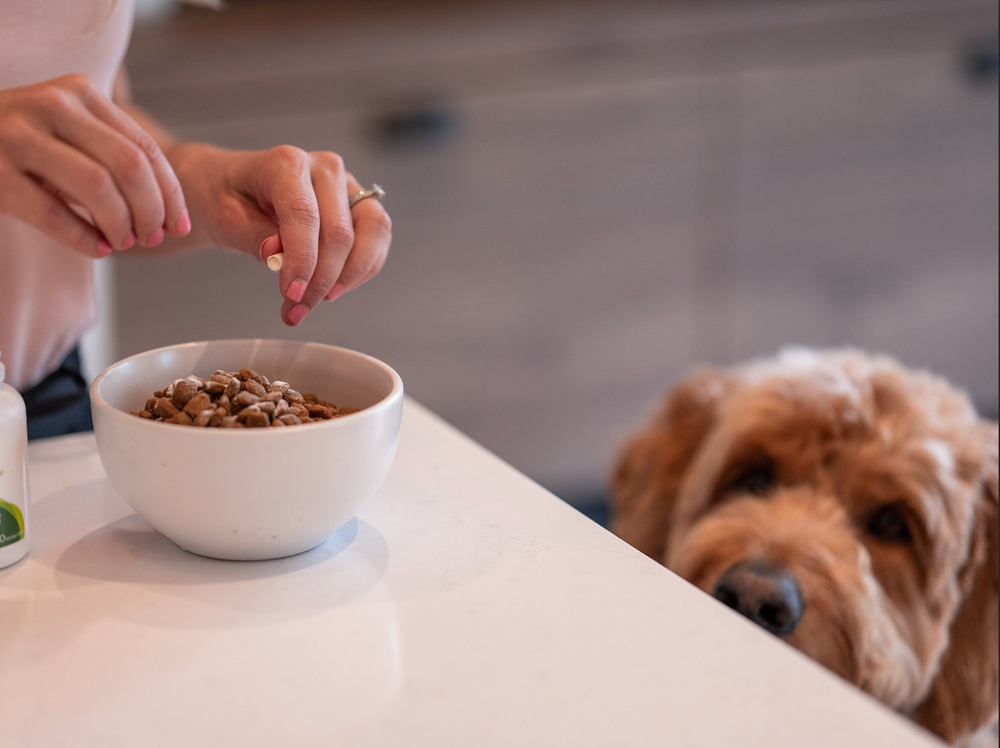Dog Separation Anxiety: Expert Tips to Help Your Pet Stay Calm at Home
List of Contents
- How Dogs Develop Separation Anxiety (and Why It Happens)
- Consequences of Ignoring Dog Separation Anxiety
- Can Dog Separation Anxiety Be Treated Successfully?
- Top Signs Your Dog May Have Separation Anxiety
- 8 Expert-Backed Tips to Calm Separation Anxiety in Dogs
- Gentle, Natural Support for Canine Separation Anxiety
- Key Takeaways
- FAQs
Dog separation anxiety is a condition that requires attention. It can weaken the immune system, trigger health issues, and lead to destructive behaviors. Over time, untreated anxiety may damage your bond and harm your dog’s overall well-being.
If you’re worried about dog separation anxiety, this guide can help. You’ll learn common triggers, key warning signs, and effective strategies to ease your dog’s stress. With patience and consistency, your pet can build confidence and enjoy a calmer, happier life at home.
How Dogs Develop Separation Anxiety (and Why It Happens)

Separation anxiety in dogs doesn’t develop overnight. It’s usually the result of multiple factors. Environment, routine changes, and even breed tendencies can all play a role. Understanding these common causes is the first step toward helping your dog feel secure:
Age and breed
Age and breed can significantly influence separation anxiety in dogs. Puppies often struggle because they rely heavily on their owners, while older or senior dogs may become more anxious as they face age-related changes. Some breeds are also naturally more prone to anxiety, making early awareness and training especially important.
Certain dog breeds, such as German Shepherds, Border Collies, and Labrador Retrievers, are more likely to develop separation anxiety. Their strong loyalty and attachment to people make them especially sensitive when left alone. Understanding breed tendencies can help owners take proactive steps to prevent anxiety-related behaviors.
While some breeds may be more prone, any dog can develop separation anxiety. Age, environment, and past experiences all play a role in triggering stress. Recognizing this helps pet owners stay alert and proactive in supporting their dogs.
Lack of early socialization
Insufficient early socialization is a major factor in canine separation anxiety. Dogs that lack exposure to different people, pets, and environments often grow overly dependent on their owners. This can result in clinginess, excessive barking, aggression, and trouble adjusting to new situations.
Brief but regular socialization experiences can make a big difference in preventing separation anxiety in dogs. Exposure to new people, pets, and environments helps build confidence and emotional resilience. Even short, positive interactions can reduce dependence on owners and encourage healthier behavior.
Traumatic events
Traumatic events are a common trigger for separation anxiety in dogs. Experiences such as abandonment, rehoming, injury, or time in an unfamiliar environment can create lasting stress. Without proper support, these events may lead to long-term anxiety and behavioral challenges.
Dogs with separation anxiety often panic when left alone and may attempt to escape confinement. In doing so, they can damage doors, crates, or windows and risk injuring themselves. Early recognition of these behaviors is crucial to protecting your dog’s safety.
Changes in routine or absence of pet parents
Sudden changes in routine or the absence of owners can trigger separation anxiety in dogs. A move, a new family member, or a shift in work schedule may disrupt their sense of stability and security. Helping your dog adjust gradually can ease stress and prevent anxious behaviors.
Even minor changes to feeding routines or playtime can cause stress for sensitive dogs. These disruptions may make them feel insecure or fear abandonment. Keeping a consistent schedule helps reduce anxiety and supports your dog’s emotional well-being.
Lack of physical and mental stimulation
Dogs require consistent physical activity and mental stimulation to stay balanced and healthy. Without daily exercise, play, and enrichment, they may become restless or insecure. This lack of engagement often increases the risk of developing separation anxiety.
Interactive games, puzzle toys, and regular walks not only prevent boredom but also build confidence. Mental challenges and physical activity help reduce stress, making it easier for dogs to handle time alone. Providing structured outlets for energy is one of the best ways to protect your dog’s emotional well-being.
Consequences of Ignoring Dog Separation Anxiety
Neglecting separation anxiety in dogs can lead to destructive behaviors like chewing, digging, and excessive barking, damaging both your home and your bond with your pet. Left untreated, these behaviors often escalate into long-term behavioral issues and potential health risks. Addressing separation anxiety early is essential for your dog’s well-being and a healthier, more harmonious relationship.
- Separation anxiety can lead dogs to destructive behaviors like chewing, digging, or tearing furniture. These actions stem from stress and fear, not disobedience. Tackling the underlying anxiety is the best way to protect both your home and your pet’s well-being.
- Dogs suffering from separation anxiety often try to escape confinement, which can put them in danger. Such attempts may cause injuries, including broken teeth, deep cuts, or even fractures. Preventing these behaviors through early intervention is essential for protecting your dog’s safety and well-being.
- Separation anxiety can place significant strain on the relationship between dogs and their owners. Frustration, stress, and destructive behaviors may weaken the bond over time. Addressing anxiety early helps restore harmony and strengthen the trust between you and your pet.
- Moreover, separation anxiety can make dogs more vulnerable to developing new fears of noises, objects, or unfamiliar people. Even minor triggers may cause strong fear reactions. Proactively addressing anxiety helps prevent these phobias from worsening over time.
- Severe separation anxiety can sometimes lead to behavior that feels overwhelming for pet parents. When destructive habits or constant stress go untreated, some dogs may face the risk of surrender or rehoming. Early intervention and consistent support are key to keeping families together and ensuring pets feel secure.
Can Dog Separation Anxiety Be Treated Successfully?

Yes. Many dogs can improve with the right approach to separation anxiety. Consistent training, environmental adjustments, and patience are key to reducing stress. With the right plan, most dogs can learn to feel more comfortable alone.
Behavior modification techniques such as systematic desensitization (gradually increasing alone time) and positive reinforcement are highly effective. While progress may take weeks or even months, steady effort produces lasting results. With consistency, it is possible to help your dog overcome separation anxiety.
Top Signs Your Dog May Have Separation Anxiety
Excessive barking, whining, or pacing when you leave or return is a common sign of separation anxiety in dogs. Some may also begin house soiling despite being fully potty trained. Recognizing these other behaviors early is essential to helping your dog cope and recover:
- Dogs with separation anxiety may show physical signs such as excessive drooling, panting, or sudden changes in appetite. In more severe cases, they may attempt to escape, damaging doors, crates, or windows in the process.
- Some dogs with separation anxiety develop compulsive behaviors such as over-grooming, licking, or chewing, which can cause bald spots and painful sores. Others may display unexpected aggression toward people or other pets.
- A key sign of separation anxiety is when stress continues even after the owner has returned home. Instead of calming down, some dogs remain restless, anxious, or unsettled. Ongoing stress like this shows the need for early intervention and consistent support.
If you notice signs of separation anxiety, consult a veterinarian, qualified pet homeopath, certified trainer, or animal behavior specialist right away. Early guidance can prevent destructive behaviors and health problems from escalating.
8 Expert-Backed Tips to Calm Separation Anxiety in Dogs

- Creating a safe space is one of the most effective ways to ease separation anxiety in dogs. Crate training or designating a small, quiet room can provide comfort and security. Stock the area with water, favorite toys, and familiar bedding to make it a positive retreat your dog enjoys.
- Gradually increasing your dog’s alone time is a proven way to reduce separation anxiety. Begin with just a few minutes, then slowly extend your absence as your dog becomes more comfortable. This step-by-step approach builds confidence and prevents panic when you leave.
- Providing mental stimulation is essential for managing separation anxiety in dogs. Activities like puzzle toys, scent games, and training exercises keep their minds busy and reduce anxious energy. For added engagement, consider doggy daycare or hiring a dog walker to provide regular interaction and enrichment.
- Associating your departure with something positive can help ease your dog’s separation anxiety. Offer a special treat, food-stuffed toy, or favorite chew each time you leave. Over time, your dog will begin to link your absence with enjoyable experiences rather than stress.
- Regular exercise and bonding are vital for managing dog separation anxiety. Just 30 minutes of daily activity can boost both mental well-being and physical health. Be sure to tailor the intensity to your dog’s age, breed, and overall condition.
- Keeping departures and arrivals low-key is an effective way to reduce separation anxiety in dogs. Avoid dramatic goodbyes or overly excited greetings, as they can heighten stress and anticipation. A calm, consistent approach helps your dog feel more secure and less anxious when you come and go.
- Using positive reinforcement is key to easing separation anxiety in dogs. Consistently reward calm behavior with treats, toys, or affection to build confidence. Over time, your dog will associate being alone with safety and comfort instead of fear.
- Recovery from separation anxiety takes time, patience, and consistency. With ongoing effort, your dog can gradually build confidence and independence. Many dogs eventually learn to remain calm and secure when left alone.
Gentle, Natural Support for Canine Separation Anxiety
Medication isn’t the only way to manage dog separation anxiety. Natural remedies, such as Zumalka’s CALMPET, help provide gentle support for dogs dealing with nervousness, noise sensitivity, or general anxiety. This homeopathic option helps promote relaxation and emotional balance without harsh effects.
CALMPET is made with natural ingredients designed to help reduce the risk of side effects often linked to conventional treatments. It helps ease anxious behaviors while supporting your dog’s overall well-being.
Key Takeaways
Separation anxiety in dogs is a serious condition that should not be ignored. Without proper care, it can lead to destructive behaviors, health issues, and heightened stress. Over time, it may also damage the bond between you and your pet.
The encouraging news is that separation anxiety in dogs can be successfully managed with the right approach. Guidance from a veterinarian, pet homeopathy specialist, or certified trainer ensures a personalized plan for your pet. With consistent care, natural support, and behavior training, your dog can feel more secure, confident, and enjoy a happier life at home.
FAQs
What is the best way to deal with a dog with separation anxiety?
The best way to manage dog separation anxiety is with gradual desensitization, positive reinforcement, and consistent routines. Adding mental stimulation, a secure environment, and professional guidance helps ease stress and fosters your dog’s confidence.
How to prevent separation anxiety in dogs when working from home?
Preventing separation anxiety in dogs while working from home starts with consistency. Establish routines, provide exercise and mental stimulation, and practice short departures. Encourage independence with safe spaces, interactive toys, and positive reinforcement to reduce stress.
How do you positively reinforce a dog with separation anxiety?
To positively reinforce a dog with separation anxiety, reward calm behavior using treats, toys, or affection. Pair departures with positive experiences, maintain consistency, and gradually extend alone time to build confidence and reduce anxiety.
How to calm an anxious dog at home?
To calm an anxious dog at home, create a quiet space, use soothing routines, and provide exercise. Puzzle toys, calming music, and positive reinforcement also reduce stress while building comfort and security.
Is it cruel to leave a dog with separation anxiety?
Leaving a dog with separation anxiety for long periods without support can be distressing and harmful. It’s not inherently cruel if managed with training, enrichment, and gradual desensitization, but untreated anxiety can severely impact their well-being.
How to train a dog to be left alone?
To train a dog to be left alone, start with short absences and gradually extend the time away. Use positive reinforcement, safe spaces, and engaging toys. Consistency, patience, and gradual desensitization help build confidence and reduce anxiety.









I am doing this kind of training to my dog. I am setting there. I didn’t know I have to ignore him whenever I come back from work. I will try that training tip. Thanks.
I love my dog way too much to do all this. He goes everywhere i go, i leave him at daycare, run errands with him, i only shop or go to dog friendly places. I cant bear the thought of leaving him alone.
Great advice but disagree about dogs sleeping alone. May experts say the best way to bond with a dog is to let him sleep with u. After all, dogs are pack animals which is why they are happiest sleeping with or being in the bedroom with you. My dog is a rescue & had severe separation anxiety. He threw himself into our glass picture window when I walked over to a neighbor’s house. Luckily he wasn’t hurt but I realized how truly terrified he was to be separated from me. I don’t believe separation anxiety is fixed by “separation. “. Our dog has slept with us from the first day he came to his “forever home” after three previous owners. He quickly became a happy, confident, trusting dog who accepted our leaving him & would nap by the door until we returned. I have no doubt your dog became used to sleeping alone. I just think it is sad that he had to.
I guess i broke all the rules. Love my pug she goes every where i go sleeps with me. And never leave her alone. And yup shes spoiled does not eat dog food
The best way for people to help their dogs feel safe, happy, and secure is to crate train them. I would never ignore my dog when I get home. I hug him, and take him outside to relieve himself. If a dog has been left free to roam around a home and is ignored when the humans return, he will most likely relieve himself on the floor in front of his human.
Leave a comment